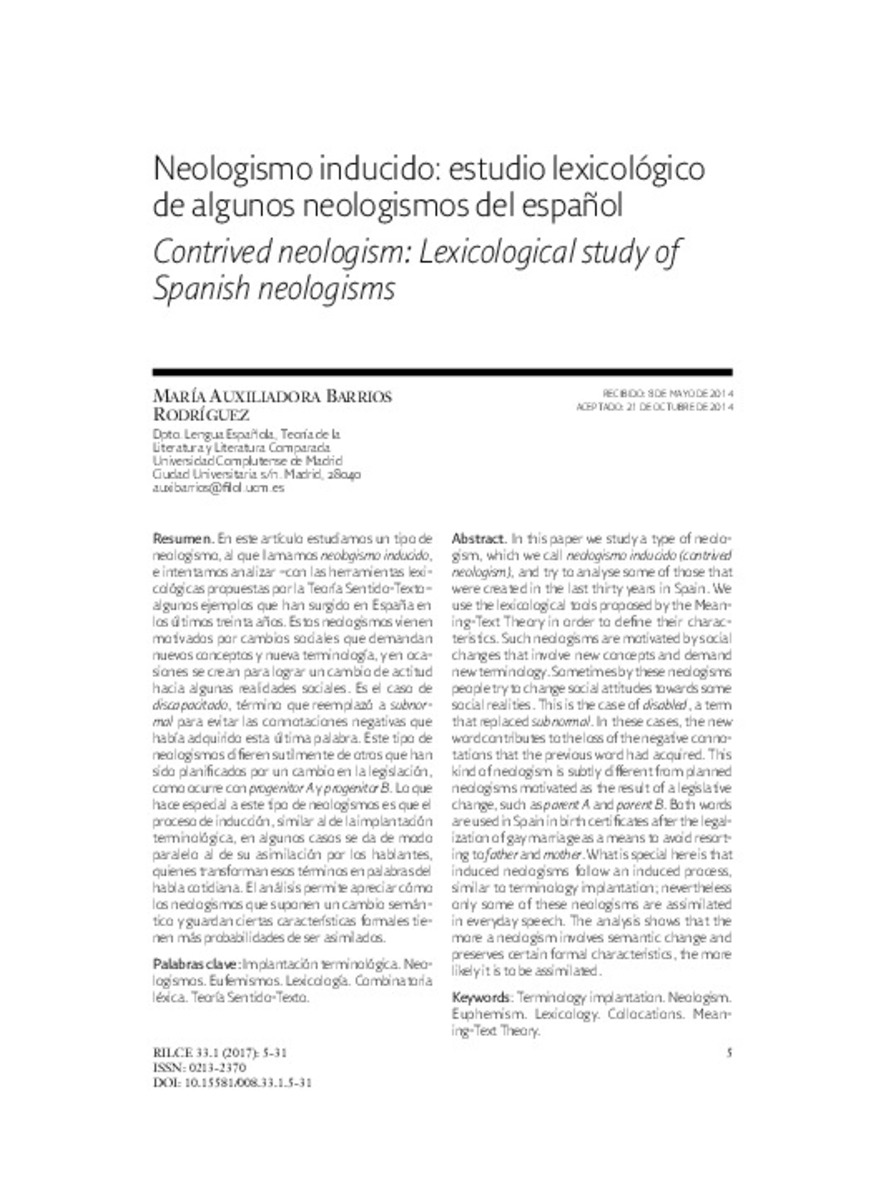Full metadata record
| DC Field | Value | Language |
|---|---|---|
| dc.creator | Barrios-Rodríguez, M.A. (María Auxiliadora) | - |
| dc.date.accessioned | 2017-06-05T09:35:44Z | - |
| dc.date.available | 2017-06-05T09:35:44Z | - |
| dc.date.issued | 2017 | - |
| dc.identifier.citation | Barrios-Rodríguez, M. A. (2017). Neologismo inducido: estudio lexicológico de algunos neologismos del español. RILCE, Vol. 33, Nº 1, pp. 5-31 | es_ES |
| dc.identifier.issn | 0213-2370 | - |
| dc.identifier.uri | https://hdl.handle.net/10171/43540 | - |
| dc.description.abstract | En este artículo estudiamos un tipo de neologismo, al que llamamos neologismo inducido, e intentamos analizar –con las herramientas lexicológicas propuestas por la Teoría Sentido-Texto– algunos ejemplos que han surgido en España en los últimos treinta años. Estos neologismos vienen motivados por cambios sociales que demandan nuevos conceptos y nueva terminología, y en ocasiones se crean para lograr un cambio de actitud hacia algunas realidades sociales. Es el caso de discapacitado, término que reemplazó a subnormal para evitar las connotaciones negativas que había adquirido esta última palabra. Este tipo de neologismos difi eren sutilmente de otros que han sido planifi cados por un cambio en la legislación, como ocurre con progenitor A y progenitor B. Lo que hace especial a este tipo de neologismos es que el proceso de inducción, similar al de la implantación terminológica, en algunos casos se da de modo paralelo al de su asimilación por los hablantes, quienes transforman esos términos en palabras del habla cotidiana. El análisis permite apreciar cómo los neologismos que suponen un cambio semántico y guardan ciertas características formales tienen más probabilidades de ser asimilados. | es_ES |
| dc.description.abstract | In this paper we study a type of neologism, which we call neologismo inducido (contrived neologism), and try to analyse some of those that were created in the last thirty years in Spain. We use the lexicological tools proposed by the Meaning-Text Theory in order to defi ne their characteristics. Such neologisms are motivated by social changes that involve new concepts and demand new terminology. Sometimes by these neologisms people try to change social attitudes towards some social realities. This is the case of disabled, a term that replaced subnormal. In these cases, the new word contributes to the loss of the negative connotations that the previous word had acquired. This kind of neologism is subtly different from planned neologisms motivated as the result of a legislative change, such as parent A and parent B. Both words are used in Spain in birth certifi cates after the legalization of gay marriage as a means to avoid resorting to father and mother. What is special here is that induced neologisms follow an induced process, similar to terminology implantation; nevertheless only some of these neologisms are assimilated in everyday speech. The analysis shows that the more a neologism involves semantic change and preserves certain formal characteristics, the more likely it is to be assimilated. | es_ES |
| dc.language.iso | spa | es_ES |
| dc.publisher | Servicio de Publicaciones de la Universidad de Navarra | es_ES |
| dc.rights | info:eu-repo/semantics/openAccess | es_ES |
| dc.subject | Implantación terminológica | es_ES |
| dc.subject | Neologismos | es_ES |
| dc.subject | Eufemismos | es_ES |
| dc.subject | Lexicología | es_ES |
| dc.subject | Combinatoria léxica | es_ES |
| dc.subject | Teoría Sentido-Texto | es_ES |
| dc.title | Neologismo inducido: estudio lexicológico de algunos neologismos del español | es_ES |
| dc.title.alternative | Contrived neologism: Lexicological study of Spanish neologisms | es_ES |
| dc.type | info:eu-repo/semantics/article | es_ES |
| dc.identifier.doi | 10.15581/008.33.1.5-31 | es_ES |
Files in This Item:
Statistics and impact
Items in Dadun are protected by copyright, with all rights reserved, unless otherwise indicated.






